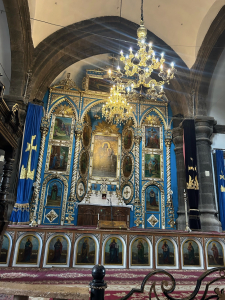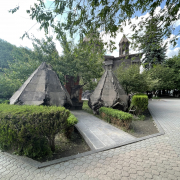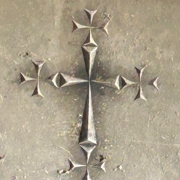Memories that Honor
Roots of Armodoxy: Memories that Honor
This week on the Roots of Armodoxy, we are looking at memories – those that honor, those that help us heal and those that keep us from moving forward. We’re looking at memories from different vantage points we’ve discovered in Gyumri, the second largest city in Armenia after Yerevan. This is the third episode of this mini-series of daily messages.
There are a couple appointments in the Church of the Seven Wounds that set it apart from other Armenian churches. The church, as we discovered, is one dedicated to the Holy Asdvadzadzin and points to “seven wounds” inflicted on the Blessed Mother, each annunciated in the Gospel of St. Luke. (See “Memories in Gyumri” for the list.) Aside from the church’s very unique name, inside the sanctuary the altar area is adorned with an iconostasis. In Eastern Orthodox churches, such as the Greek or Russian Orthodox Churches, the iconostasis is a wall of icons and religious paintings, separating altar area from the nave of the church. In the Armenian Apostolic Church, that separation is demarked by a curtain. Secondly, in one of the side rooms where congregants are invited to light their devotional candles, there is a large crucifix hanging from one of the walls. Crucifixes are not part of the Armenian Church tradition, partly because the symbol of the cross emphasizes resurrection for the Armenian Church, that is, Jesus’ conquering the cross and our ability to do likewise.
These two unusual appointments – to reiterate, they are unusual within the Armenian Church – the iconostasis and the crucifix are reminders of the ecumenic spirit that is often overlooked when people think of the Armenian Church. Gyumri is on the crossroad of the continents and had visitors from different countries. The large Crucifix was left by a Roman Catholic congregation which was granted use of the Church of the Seven Wounds by the Armenians during the World War II, when the Catholics did not have a place to worship.
Ecumenism is the idea that Christians of different Christian denominations should work together to develop closer relationships to promote Christian unity. One of the pioneers of ecumenism was St. Nersess Shnorhali, the 12th century Saint and Patriarch of the Armenian Church. He offered a formula for Christian understanding which has been adopted by many church leaders through the centuries.* Shnorhali says that as Christians we must be united in essentials, approach secondary items of faith with liberty and display charity (love) in all things.
Essential items are the articles of Faith. We are united in our understanding of God as Father, the Son and the Holy Spirit. This is essential. Secondary matters might be practices which differ from place to place, community to community. Is the Crucifix necessary? Should you adopt a vegan diet as a Christian? And finally, we approach all our relationships with one another in a spirit of love, to promote Christ’s Birth announcement: Peace on Earth and Goodwill toward one another.
The Armenian Church has lived and survived by this simple code of ethics as articulated by St. Nersess Shnorhali. In the Church of the Seven Wounds, we find memories, remembrances, that honor the spirit of Christian Unity.
As our prayer today, we remember the words from the Gospel of John, and our Lord, Jesus Christ did say, “I am the good shepherd; and I know My sheep, and am known by My own. As the Father knows Me, even so I know the Father; and I lay down My life for the sheep. And other sheep I have which are not of this fold; them also I must bring, and they will hear My voice; and there will be one flock and one shepherd.” Amen. (10:14-6)
* There are those who contend that this formula was given developed by Augustine of Hippo, but modern scholarship has shown otherwise.



 2023 Epostle.net
2023 Epostle.net 2025 Fr Vazken
2025 Fr Vazken 2023 Fr. Vazken Movsesian
2023 Fr. Vazken Movsesian
 2009 Fr. Vazken Movsesian
2009 Fr. Vazken Movsesian



 2023 Epostle.net
2023 Epostle.net
Leave a Reply
Want to join the discussion?Feel free to contribute!